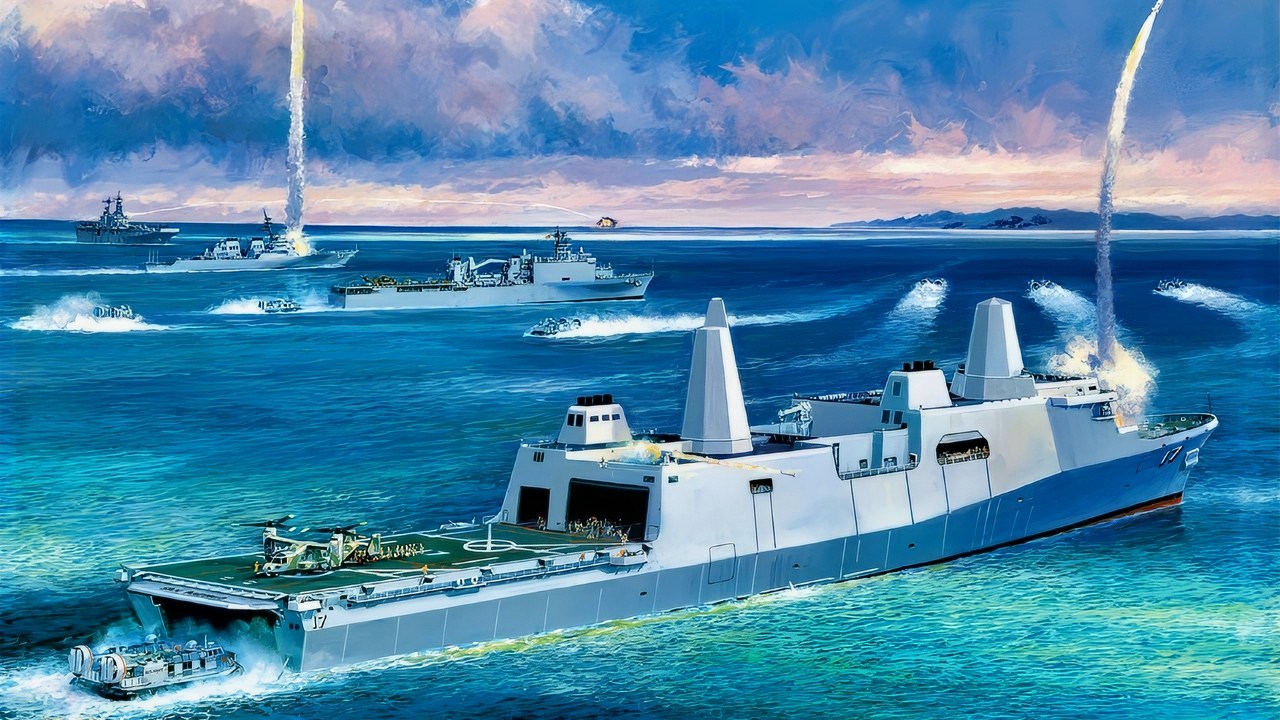Key Points and Summary – The U.S. Navy’s San Antonio-class amphibious transport docks, designed to be modern and survivable platforms for Marine assaults, are critiqued as dangerously under-armed “sitting ducks.” National Security Journal was able to get close to this photo recently and took several original images to provide our readers with a closer look.
-Despite their innovative design, the ships lack any organic medium or long-range offensive firepower to support the troops they deploy, and their defensive weapon suite is also considered modest.
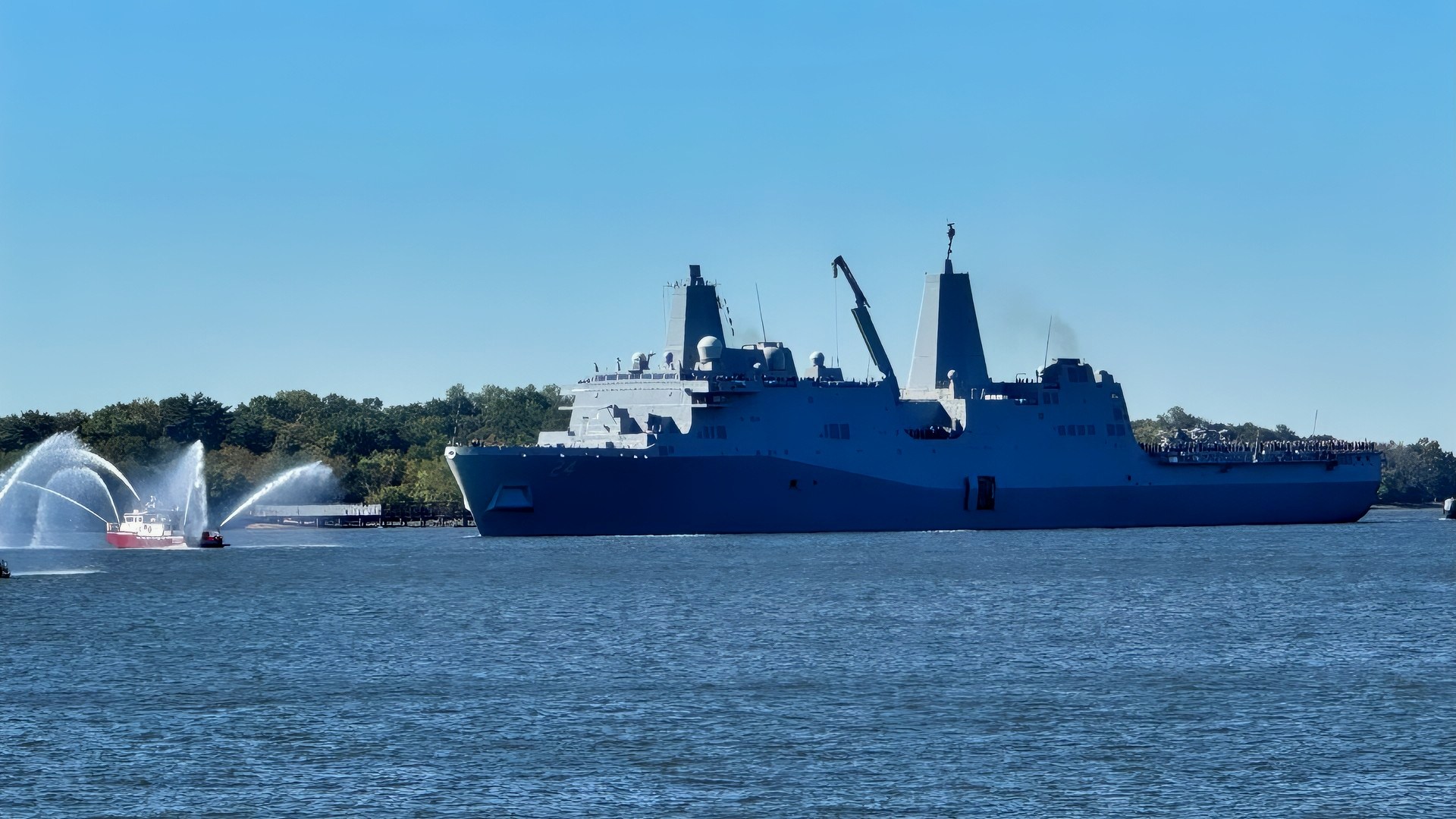
San Antonio-Class. Image Taken October 2025 by National Security Journal.
-Initial plans to include Vertical Launch System (VLS) cells were scrapped, leaving them dependent on other ships for protection and fire support.
-Without significant armament upgrades, these forward-deployed vessels would find it difficult to survive in a contested amphibious operation.
Meet the San Antonio-Class Amphibious Transport Dock
The San Antonio-class amphibious transport docks combine the roles of several previous Navy ships into one platform.
The docks were explicitly designed to be more survivable and reduce maintenance and servicing requirements.
But despite the advantages offered by the docks, they lack a robust offensive and defensive weapon suite—a curious decision for what would be, in the event of a Marine-led amphibious assault, a very forward-deployed US Navy asset.
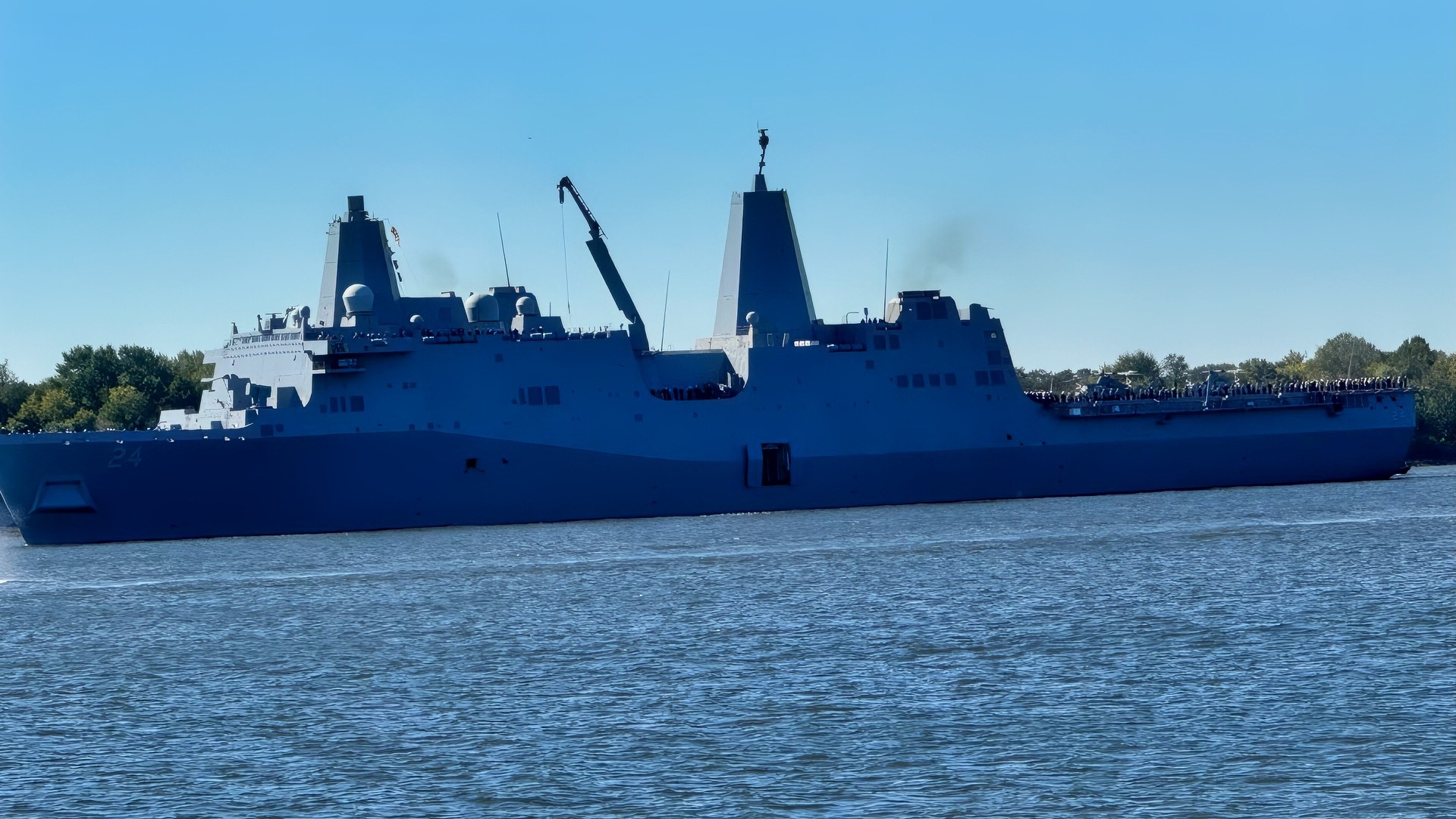
San Antonio-Class. Original Image taken for National Security Journal.
The San Antonio-class amphibious transport dock was a significant change in amphibious ship design for the US Navy and Marine Corps. Compared to older LSTs, LSDs, and Austin-class amphibious warfare ships, the San Antonio-class is larger, allowing the ships to more easily launch and recover vehicles and aircraft.
One of the class’s central goals was a design approach aimed at lowering operating costs over its service lifetime while also easing maintenance and boosting survivability.
The class is a significant improvement over previous generations of Navy ships, which combined the roles of several disparate ships onto a single hull. The San Antonio-class was designed from the outset for operations with the United States Marine Corps and their kit.
Cooperation with the end user, a United States Marine, was extensive.
A publication covering the class’s design from 1999 explained that “Team 17 designers have directly interfaced with Marine combat cargo assistants to ensure that a combat-loaded Marine can move comfortably through the LPD 17 passageways. In addition, the Marine Corps forwarded an advanced copy of their planned 21st century backpack to Avondale Industries to ensure that the ship design will also meet future anticipated requirements.”
The class was explicitly designed with the MV-22 Osprey tiltrotor aircraft in mind, making it better equipped to liaise with that aircraft and other ship-to-shore connectors for disembarking Marines.
The San Antonio-class also adopted a concurrent engineering design philosophy that directly sought input from users and maintainers into the ship’s design, to reduce maintenance burden and improve ease of use. To that end, the San Antonio-class’s information network backbone is a fiber-optic system called the Shipboard Wide Area Network (SWAN), which eases communication with the ship’s diagnostics and communications tools.
Despite the class’s multiple positive innovations, the San Antonio-class ships lack a robust offensive weapon suite. And though they are equipped with modest defensive weapons, they lack the more robust defenses of other US Navy ships.
Proposals for retrofitting the ship with offensive weapons have been studied, with proposals like installing VLS cells for Tomahawk missiles or other long-range weapons evaluated. Though positive, the retrofit hasn’t been implemented more broadly across the fleet.
Originally, plans for the class included a pair of 8-cell Mk-41 Vertical Launch System cells, but the VLS system was removed from the ship’s design during the construction of the USS San Antonio, the first of the class.
The lack of containerized munitions—both for offensive and air defense purposes—has been an issue the Marine Corps has sought to address for at least a decade.
“It’s certainly an asset we’d like to have,” Marine Major General Chris Owens explained to USNI News back in 2016.
“We are exploring that to see how much it would cost and see what the tradeoffs might be, but certainly it would be in line with the concept of distributed lethality and advanced expeditionary operations in a sea control environment.”

(July 28, 2022) U.S. Navy Zumwalt-class guided-missile destroyer USS Michael Monsoor (DDG 1001) sails in formation during Rim of the Pacific (RIMPAC) 2022, July 28. Twenty-six nations, 38 ships, three submarines, more than 30 unmanned systems, approximately 170 aircraft and 25,000 personnel are participating in RIMPAC from June 29 to Aug. 4 in and around the Hawaiian Islands and Southern California. The world’s largest international maritime exercise, RIMPAC provides a unique training opportunity while fostering and sustaining cooperative relationships among participants critical to ensuring the safety of sea lanes and security on the world’s oceans. RIMPAC 2022 is the 28th exercise in the series that began in 1971. (U.S. Navy photo by Mass Communication Specialist 3rd Class Aleksandr Freutel)
A Lack of Armaments
As one of the most forward-deployed ships in an amphibious assault, it is a curious fact that the San Antonio-class amphibious transport docks lack any medium or long-range armaments that could be leveraged to support disembarked Marines. The troubled Zumwalt-class can partly explain the decision.
Based on an innovative tumblehome hull designed to cut through waves and prevent detection by enemy radar, the Zumwalt-class ships were an ambitious class of destroyers. The centerpiece of the ship’s armament, as originally designed, saw a pair of 155mm naval artillery guns fitted into two pods at the ship’s bow.
Folded into a specially-designed container that preserved the Zumwalt’s stealth characteristics, the ship’s guns were intended to support dismembered shore elements from afar.
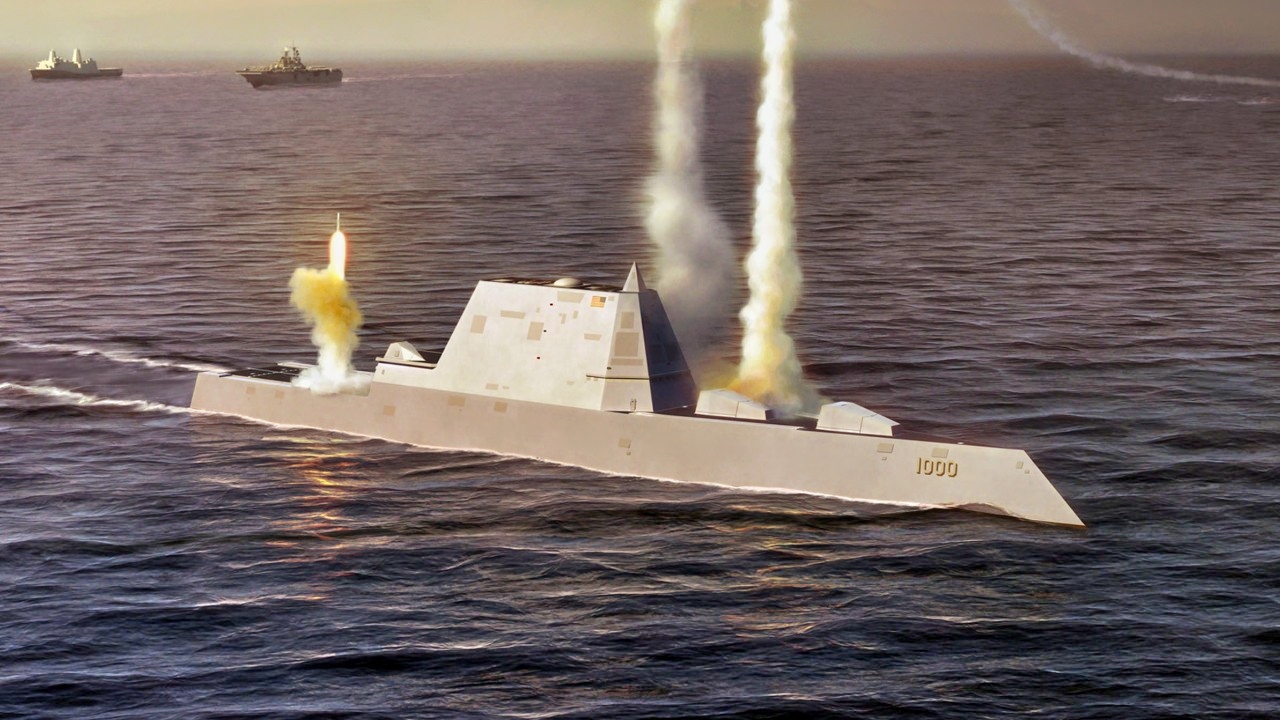
The US Navy’s troubled Zumwalt-class destroyers are being revitalized with the integration of Conventional Prompt Strike (CPS) hypersonic missiles, transforming them into powerful long-range strike platforms. The original class of 32 ships was cut to just three after its Advanced Gun System failed due to exorbitant costs. Now, these stealthy, $8 billion warships are having their defunct guns replaced with vertical launch tubes for hypersonic weapons. This upgrade will dramatically increase their strike range from a mere 63 miles to over 1,700 miles, making the Zumwalts relevant and formidable assets for deterring adversaries like China in the 21st century.
The Zumwalt design was incredibly ambitious. Unfortunately, it was also costly. At nearly $1,000,000 per shot, the guns—which are incompatible with standard 155mm artillery ammunition—were ultimately removed from the ships, and the class was severely curtailed at just three ships.
Removing the problematic Advanced Gun System freed up space inside the hull for installing additional containerized munitions, some of which could potentially be large hypersonic weapons, complementing the other missiles arrayed along the Zumwalt’s periphery.
Following the containerized retrofit, the Zumwalt-class could support Marines on shore. But thanks to a truncated fleet of just three ships, the Zumwalt fleet would need to expand dramatically to offer a credible shore support capability.
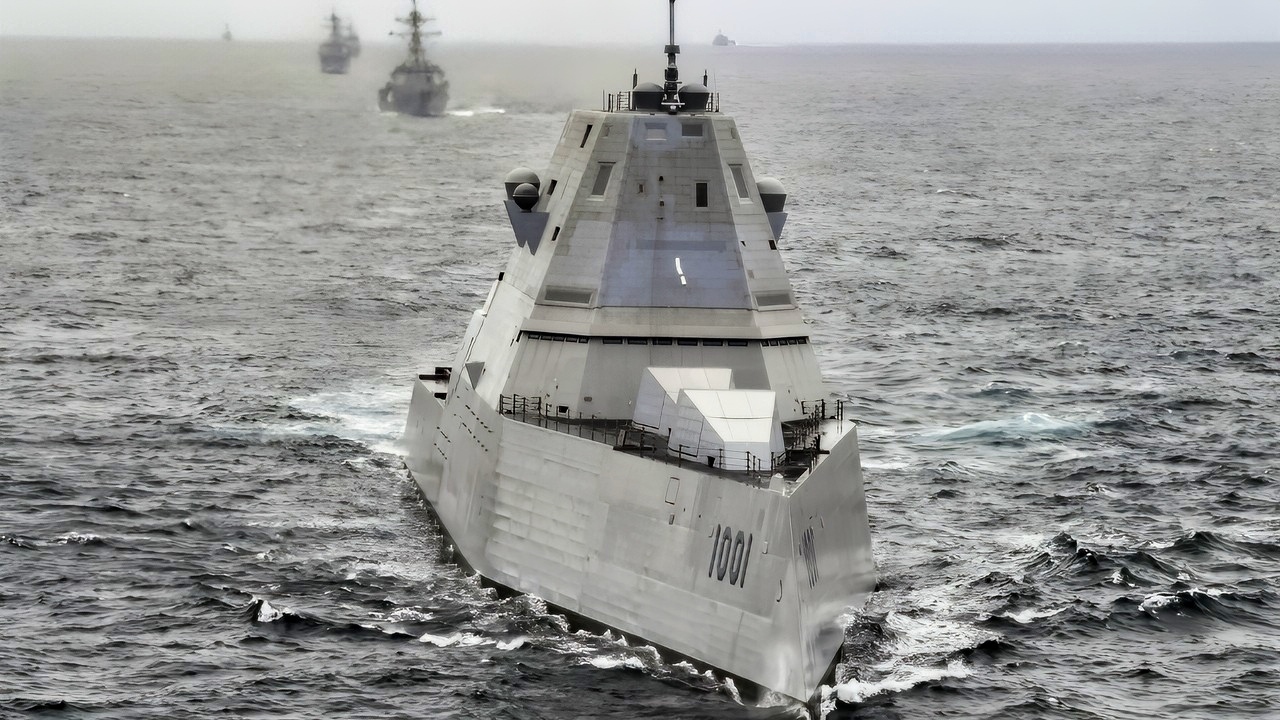
(April 21, 2021) The Zumwalt-class guided-missile destroyer USS Michael Monsoor (DDG 1001) leads a formation including the Arleigh Burke-class guided missile destroyers USS Fitzgerald (DDG 62), USS Spruance (DDG 111), USS Pinckney (91), and USS Kidd (DDG 100), and the Independence-variant littoral combat ship USS Coronado (LCS 4) during U.S. Pacific Fleet’s Unmanned Systems Integrated Battle Problem (UxS IBP) 21, April 21. UxS IBP 21 integrates manned and unmanned capabilities into challenging operational scenarios to generate warfighting advantages. (U.S. Navy photo by Chief Mass Communication Specialist Shannon Renfroe)
Postscript
For the sake of the San Antonio-class’s survivability, as well as the survivability of disembarked Marines on shore, the transport docks would need an organic offensive capability, and one complemented by a defensive weapon suite with deep magazines to fend off the inevitable anti-ship weaponry they would be likely to face in an amphibious assault scenario.
Until those capabilities are forthcoming, however, the San Antonio-class may find it difficult to survive.
About the Author: Caleb Larson
Caleb Larson is an American multiformat journalist based in Berlin, Germany. His work covers the intersection of conflict and society, focusing on American foreign policy and European security. He has reported from Germany, Russia, and the United States. Most recently, he covered the war in Ukraine, reporting extensively on the war’s shifting battle lines from Donbas and writing on the war’s civilian and humanitarian toll. Previously, he worked as a Defense Reporter for POLITICO Europe. You can follow his latest work on X.
More Military
Army MV-75 Has a “Digital Backbone” to Stand Up to China in the Pacific
The F-35 Stealth Fighter Great Leap Forward Has Arrived
New Challenger 3 NATO Tank Is Built for Just 1 Mission It Can’t Fulfill
Sunk 10,000 Feet Down: A U.S. Navy Nuclear Submarine Was Lost, And No One Knows Why


